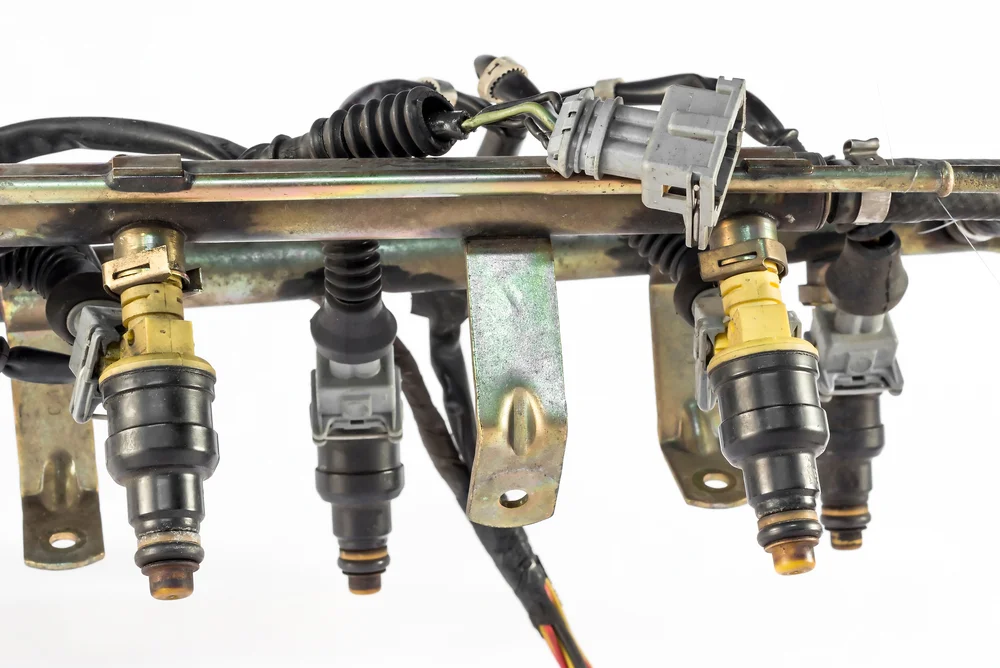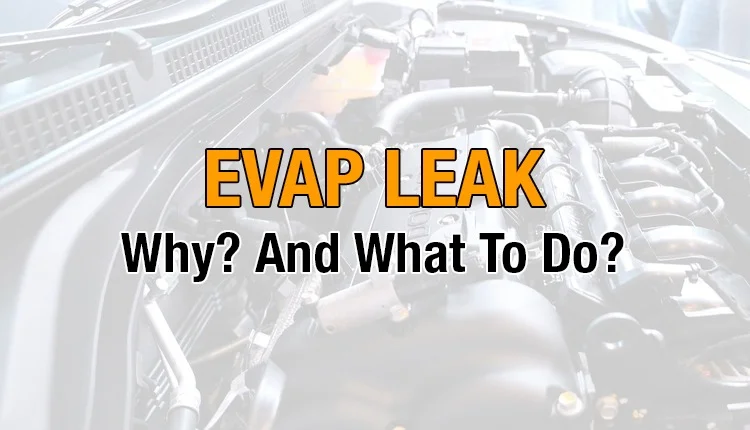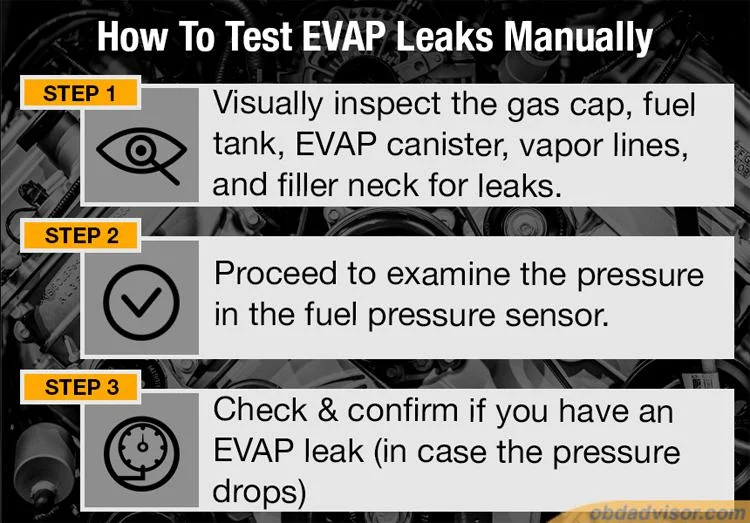There are over a thousand things that can trigger your car’s “Service Engine Soon” or “Check Engine” light.
One of them is a faulty EVAP system.
On this page, you will find everything you need to know about your car’s EVAP system, including possible causes and solutions to an EVAP leak.
Evaporative (EVAP) System: What Is It?
Most people only know it as the EVAP system, but it’s actually called the Evaporative Emission Control System. By definition, it is a closed vehicle system that captures and prevents gas vapors from escaping into the atmosphere.
So why is the EVAP system necessary in vehicles?
Primarily to reduce pollution and enhance the vehicle’s performance. The Environmental Protection Agency (EPA) requires that all cars (made from 1996) have this system.
As a fuel, gasoline contains several hydrocarbon elements. The light ones like aromatics, aldehydes, paraffin, and olefins EVAPorate quickly and easily. When they react with air in the presence of sunlight (photochemical reaction), they form a substance called smog. That’s why EVAP tests are also called smog tests.
If not completely sealed, the fuel tank will allow vapors to escape into the atmosphere. That will happen even when you are not driving the vehicle. Meaning your car can pollute for 24 hours a day.
Such uncontrolled EVAP pollution is what is known as an EVAP leak. It can account for up to 20% of a vehicle’s pollution. The EVAP system is what prevents that from happening. More on EVAP leaks a little later, but for now…
Components Of An EVAP System
The Evaporative Emission Control System consists of the fuel tank, gas cap, liquid-vapor separator, and EVAP canister. The fuel tank holds fuel. It’s usually constructed with some expansion space to allow fuel to expand (on a hot day) without overflowing or leaking.
The gas cap closes the entrance to the fuel tank. For OBD2 vehicles (1996 and newer), it’s usually sealed completely. Such cars have venting done through the EVAP canister. On the other hand, OBD1 vehicles (older than 1996) have a gas cap with a vacuum/pressure release valve for venting.
The liquid-vapor separator prevents liquid gasoline from getting into the vent line. Ultimately, that ensures that gas doesn’t enter the EVAP canister. If that happens, the canister will overload and may leak.
On its part, the EVAP canister traps, and stores fuel vapors. Typically made of steel or plastic, the canister is usually located in the rear quarter panel or the engine compartment. Either way, it’s hidden from view.
Inside the canister is activated charcoal, whose purpose is to absorb fuel vapors. The vapors will be stored until you start your vehicle’s engine. Once the car starts running, it will generate some heat. The PCM will then open the canister’s valve and allow the gas vapors to make their way into the engine.
How Do You Know That You Have An EVAP Leak?

Credit: yourmechanic.com
Now, back to EVAP leaks.
Although the EVAP system doesn’t require maintenance, it can get faults that turn the Check Engine Light on. The errors typically arise from system weaknesses and/or failures.
Perhaps more interestingly, EVAP leaks don’t usually affect how a car drives. You may only notice or suspect them when the Check Engine Light starts flashing. And that right there is the first sign of an EVAP leak – the Check Engine Light (CEL).
Unfortunately, as mentioned already, there are thousands of other things that can trigger the CEL. So how do you narrow it down to an EVAP leak? Some vehicles usually have an accompanying popping sound.
However, that alone will not give you a precise diagnosis; but an EVAP system test will. You can either do a manual test or use a scan tool. Read on to learn how to do EVAP leak diagnoses using both methods.

Causes Of An EVAP Leak

Knowing the possible causes of an EVAP leak will help you diagnose and fix it better. The common ones include:
- Missing fuel cap
- Loose fuel cap
- Using incorrect fuel cap
- Leaks in the fuel tank
- Leaks in EVAP canister
- Leaking vents and vacuum hoses
- Faulty purge valve. The valve vents fuel vapors to the engine.
Why You Should Never Drive With An EVAP Leak
It is possible to drive a vehicle that has an EVAP leak. But you should avoid that as much as possible. Why? For starters, it will pollute the environment.
Secondly, your vehicle will not pass the state and/or federal emission tests. That’s a traffic offense by its own merits.
Thirdly, the vehicle’s performance may be affected. While driving won’t be an issue, it may take longer to start and record lower fuel mileage. In short, you risk spending more on gas.
How To Diagnose EVAP Leaks
There are two ways of diagnosing EVAP leaks. The first is using manual tests, and the second involves using a scan tool.
How To Manual Test

Start by visually inspecting the gas cap, fuel tank, EVAP canister, vapor lines, and filler neck for leaks. Make sure the vehicle is not running, and the vent solenoids are closed. You will also need an evaporative leak detector for a manual test.
Proceed to examine the pressure in the fuel pressure sensor. With the vent valve and purge valve closed, watch how the pressure changes.
If it drops, you have an EVAP leak, but if it doesn’t, your EVAP system is working perfectly.
Find your Evaporative Leak Detector Here
How To Test EVAP Leak With A Scan Tool
A more straightforward way of testing for EVAP leaks is by using a scan tool. In addition to other functions, OBD2 scanners check EVAP systems to ensure that hydrocarbons don’t escape into the atmosphere.
Usually, OBD EVAP monitors run once every drive cycle when the fuel tank is between 15 and 85% full.
They use sensors known as “purge flow sensors” to identify even the smallest of leaks. If there’s a leak, the scanner will tell you by displaying a fault code.
EVAP fault codes range from P0440 to P0457. Here is what each one of them means:
Evaporative System OBD2 Codes Meaning
P0440 Faulty evaporative emission control system
P0441 Incorrect purge flow in the evaporative emission control system
P0442 Small leak in EVAP emission control system
P0443 Purge control valve circuit in EVAP emission control system
P0444 Control valve circuit is open
P0445 Short in control valve circuit
P0446 Evaporative emission control system vent control circuit
P0447 Evap emission control system vent control circuit is open
P0448 Short in EVAP emission control system vent control circuit
P0449 EVAP emission control system vent valve/solenoid circuit
P0450 Evaporative emission control system pressure sensor
P0451 EVAP emission control system pressure sensor
P0452 Low input in EVAP emission control system pressure sensor
P0453 High input in EVAP emission control system pressure sensor
P0454 Intermittent EVAP emission control system pressure sensor
P0455 Gross leak in EVAP emission control system
P0456 Small leak in EVAP emission control system
P0457 Fuel cap leak in EVAP emission control system
What To Do With An EVAP Leak?
Not all EVAP leaks are equal. While some require a big budget and professional repair, others are easily fixable. For instance, if you run into P0440, P0455, and/or P0457 fault codes, simply check that the gas cap is tightly in place and that there’s no debris or damage in the filler tank inlet. If, after doing that, the code still persists, consider replacing the gas cap altogether.
The one code you don’t want is the P0442. It indicates that the EVAP system has a leak. Besides being hard to find, the EVAP leak will require a professional auto mechanic to fix it. And if it’s the EVAP canister that’s damaged, it may require replacement (depending on the extent of the damage).
Generally, the average cost of a new vapor canister ranges from $150 to $430 (exclusive of labor costs). Luckily you can avoid such expenses easily just by not overfilling the fuel tank.
The Bottom Line
Keeping your EVAP system in check will go a long way in ensuring that there are no EVAP leaks. Remember that an EVAP leak not only leads to pollution, but your car will not pass a smog test. That’s why you need to run EVAP system checks as frequently as possible.
You can do that manually or use a scan tool. The latter is more reliable since it’s easier and accurate. Just make sure you know how to pull and interpret the codes. Feel free to refer to the table above for what each code means.